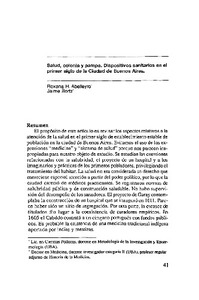Please use this identifier to cite or link to this item:
https://repositorio.uca.edu.ar/handle/123456789/18552| Título: | Salud, colonia y pampa. Dispositivos sanitarios en el primer siglo de la Ciudad de Buenos Aires Health, colony and the pampas. public health measures in the first century of the city of Buenos Aires |
Autor: | Abelleyro, Roxana H. Bortz, Jaime |
Palabras clave: | SALUD; PRACTICA DE LA MEDICINA | Fecha de publicación: | 2007 | Editorial: | Pontificia Universidad Católica Argentina. Facultad de Derecho y Ciencias Sociales del Rosario. Instituto de Historia | Resumen: | El propósito de este artículo es revisar los aspectos relativos a la
atención de la salud en el primer siglo de establecimiento estable de
población en la ciudad de Buenos Aires. Evitamos el uso de las expresiones
"medicina" y "sistema de salud" porque nos parecen inapropiadas
para nuestro objeto de estudio. Se estudian las cuestiones
relacionadas con la salubridad, el proyecto de un hospital y a los
imaginarios y prácticas de los primeros pobladores, privilegiando el
tratamiento del habitar. La salud no era considerada un derecho que
mereciese especial atención a partir del poder político, por lo que la
ciudad careció de médicos practicantes. Se registraron normas de
salubridad pública y de construcción saludable. No hubo supervisión
del desempeño de los sanadores. El proyecto de Garay contemplaba
la construcción de un hospital que se inauguró en 1611. Parece
haber sido un sitio de segregación. Por otra parte. la escasez de
titulados dio lugar a la coexistencia de curadores empíricos. En
1605 el Cabildo contrató a un cirujano portugués con fondos públicos.
Es probable la existencia de una medicina tradicional indígena
aportada por indias y mestizas. The purpose of this article is to review the issues related to health care over the first century of the stable settlement of population in the city of Buenos Aires. We have avoided the use of the words "medicine'" and "public health system" because we find them inappropriate for the subject matter of our study. We have studied the issues related to sanitation, the projects to build a hospital and the first settlers' collective representations and practices, prioritizing the treatment of dwelling places. Health was not considered a right deservi ng any special attention of the political power. Therefore, the city did not have any practicing physicians. Rules related to public health and sanitary constructions were registered. Toe healers' performance was not supervised. Garay's project included the construction of a hospital which was opened in 1611. Apparently, said hospital was a segregation site. On the other hand, the shortage of qualified physicians gave rise to the existence of empiric mediciners. In 1605, the Cabildo (town council) hired, with public funds, a Portuguese surgeon. Indigenous medicine contributed by Amerindian and half-blood women is likely to have existed. |
Cobertura Espacial: | Buenos Aires (Argentina : ciudad) | Cobertura Temporal: | Siglo XVII | URI: | https://repositorio.uca.edu.ar/handle/123456789/18552 | ISSN: | 2525-0884 (online) 0325-772X (impreso) |
Disciplina: | HISTORIA | Derechos: | Atribución-NoComercial-CompartirIgual 4.0 Internacional | Fuente: | Res Gesta. 2007, 45 |
| Appears in Collections: | RG - 2007 nro. 45 |
Files in This Item:
| File | Description | Size | Format | |
|---|---|---|---|---|
| salud_colonia_ pampa.pdf | 5,36 MB | Adobe PDF |  View/Open |
This item is licensed under a Creative Commons License

